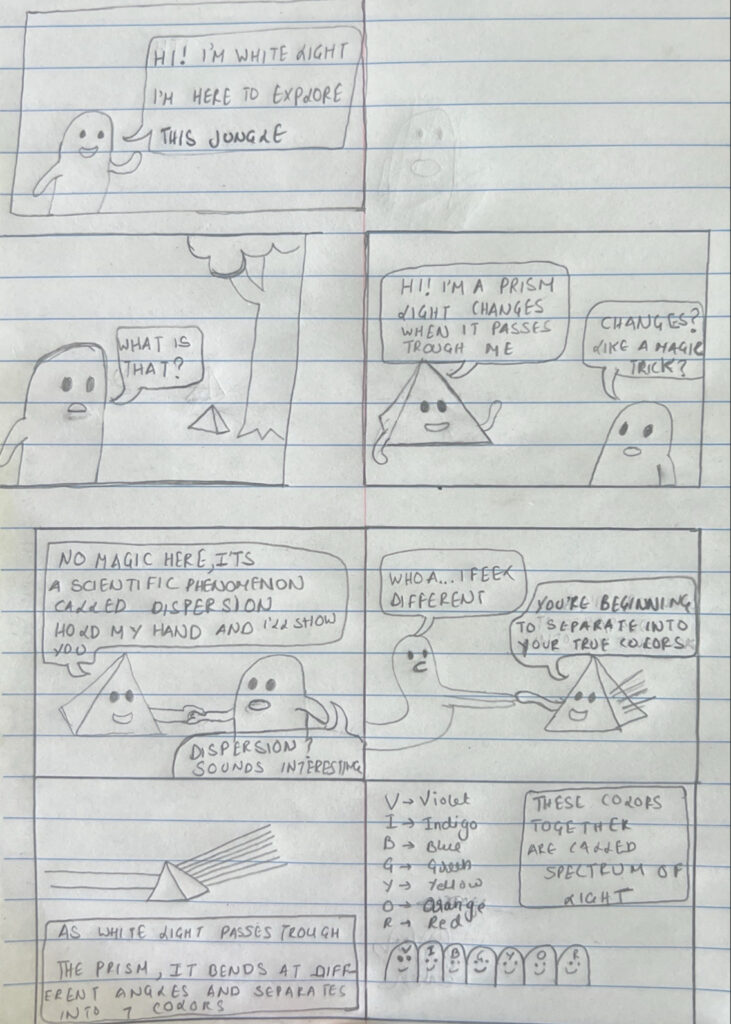Challenge A: Prototype
“Dispersion of White Light”
Author: Kushank Virdi
THE PROCESS
Phase 1: Understand (Discover, Interpret, Specify)
DESCRIBE THE CHALLENGE:
Many people struggle to understand why white light is not just “plain,” but actually a combination of multiple colors. The concept of dispersion can feel abstract when presented only as a diagram. This comic uses simple characters (White Light, Prism, and the seven colors) to make the phenomenon easy, engaging, and memorable.
CONTEXT AND AUDIENCE:
The audience for this comic could be anyone who has ever wondered “Why do I see a rainbow?” or is curious about the basics of physics and optics.
The format appeals to a wide range of readers—from children learning science for the first time, to adults who enjoy fun explanations of everyday phenomena. Visual cues (like White Light stretching, splitting, and transforming into colors) make the invisible process tangible. Humor and personification reduce intimidation while keeping the material engaging.
This broad approach means the comic works both as an educational resource and as a playful way to satisfy natural curiosity about the world.
POV STATEMENT:
Learners who see light as something “plain” need to experience how mediums such as prisms/raindrops reveal its hidden colors, so they can better understand the concept of dispersion and connect it to real-world rainbows.
LEARNING OBJECTS:
Primary Objectives
- Learners can explain that white light is made of seven colors.
- Learners understand that recombining the seven colors produces white light.
- Learners can define dispersion as the bending of light at different angles through a prism.
- Learners can connect dispersion to real-world phenomena like rainbows.
Sub-Objectives
- Learners recognize that each color bends differently (red least, violet most).
- Learners retain the concept more easily through character-driven storytelling and visuals.
Plan (Ideate, Sketch, Elaborate)
IDEATION:
I considered different approaches to teaching dispersion:
- A purely diagrammatic, science-textbook style explanation.
- A real-world rainbow example.
- A character-driven narrative.
I chose the character-driven story because it makes the concept approachable and fun. White Light begins as a “plain” character, unsure of itself. The Prism introduces dispersion, guiding White Light through the transformation. The seven colors emerge as distinct personalities, introducing the concept of the visible spectrum. Finally, the comic ties dispersion to rainbows and shows that combining colors returns to white light.
This structure helps readers follow the science in a step-by-step manner while staying engaged.
STORYBOARD(Key Panels):
Panel 1
Visual: White Light introduces itself/Walks through the trees.
Text: “Hi! I’m White Light. I’m here to Explore this Forest”
Panel 2
Visual: White Light sees the Prism.
Text: “What is that?”
Panel 3
Visual: Prism introduces itself.
Text: “Hi! I’m a Prism. Light changes when it passes through me.”
White Light: “Changes? Like a magic trick?”
Panel 4
Visual: Prism reaches out.
Text: Prism: “No magic here — it’s called dispersion. Come on, hold my hand and I’ll show you.”
White Light: “Dispersion? That sounds… interesting.”
Panel 5
Visual: White Light halfway inside Prism, stretching.
Text: White Light: “Whoa… I feel different!”
Prism: “You’re beginning to separate into your true colors.”
Panel 6
Visual: White Light fully splits into 7 beams.
Narration: “As White Light passes through the prism, it bends at different angles and separates into 7 colors.”
Panel 7
Visual: Seven colorful characters wave.
Narration: “These colors together are called the spectrum of light.”
Panel 8
Visual: Prism comes and explains that the same effect happens in raindrops and relates it to rainbows.
Narration: “Raindrops act like tiny prisms — that’s how rainbows appear.”
Panel 9
Visual: Red and Violet at ends of rainbow.
Narration: “Red bends the least, Violet bends the most.”
Panel 10
Visual: The prisms tells that it’s time to bring the white light back and places itself upside down.
Narration: “When the 7 colors combine, they appear white.”
Panel 11
Visual: White Light reappears smiling.
Text: “I thought I was plain, but I’m actually a rainbow in disguise!”
Panel 12
Visual: White Light and spectrum together.
Narration: “One becomes many, and many become one.”
Prototype(First 7 panels)
Note: The panel orientation will be fixed and refinements will be made before the final submission.
Also planning to digitally create this comic, which would further improve the visuals.

Principle
1. Segmenting Principle
Each panel shows one step of the process — curiosity, entering the prism, stretching, splitting, rainbow, and recombination — so readers learn gradually without overload.
2. Dual Coding Theory
The idea of dispersion is taught through both visuals (characters, beams of color, prism, rainbow) and text (narration boxes and simple dialogue). By pairing words with images, readers can form stronger mental connections and better remember how white light splits into seven colors.
3. Personalization Principle
Abstract science is made approachable by turning White Light, the Prism, and the seven colors into characters with simple expressions and dialogue. Using a conversational, story-like tone keeps the explanation engaging and relatable for anyone curious about rainbows or light.